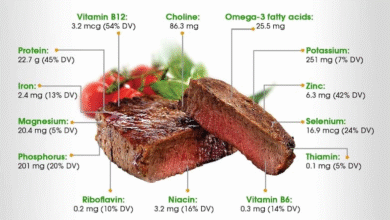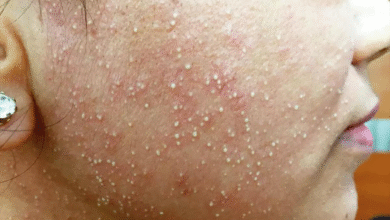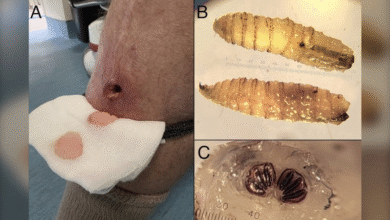Sunburn Tattoos: The Hidden Dangers for Teenagers’ Skin

Sunburn tattoos have emerged as a controversial trend among teenagers, who intentionally expose their skin to harmful UV rays while using stickers or sunscreen to create eye-catching designs. While these artistic expressions may garner attention on social media, dermatologists warn that the dangers of this practice extend far beyond aesthetic appeal. Each instance of sunburn is a sign of skin damage, increasing the skin cancer risk as well as the potential for premature aging due to UV damage. Experts emphasize that the risks associated with sun exposure are particularly pronounced for young skin health, as this demographic may not fully grasp the long-term consequences of their actions. Instead of pursuing such harmful trends, teenagers and young adults should consider tan alternatives that protect their skin while allowing them to express their creativity safely.
The phenomenon of creating “suntan tattoos” through deliberate sunburning has captivated a younger generation, often driven by the desire for unique and stylish body art. However, this reckless pursuit of temporary designs disregards the significant dangers tied to UV radiation and its effect on skin health. In light of the concerning trend, experts are urging individuals to recognize the severe risks associated with skin injury from excessive sun exposure. With increasing evidence linking sunburn to skin cancer, including the deadly melanoma, there is a pressing need for alternative approaches that prioritize safety over superficial aesthetics. Emphasizing safer practices can help foster a greater understanding of skin protection and the avoidance of long-term health consequences.
The Rise of Sunburn Tattoos Among Teenagers
In recent months, the trend of sunburn tattoos has rapidly gained popularity among teenagers, especially on platforms like TikTok. This practice involves deliberately exposing the skin to harmful UV rays while using various forms of stickers or tape to create artistically shaded patterns. While many young people believe they are engaging in harmless fun that enhances their social media presence, dermatologists are sounding the alarm about the potential dangers associated with this trend. The practice is not only detrimental to skin health but also significantly elevates the risk of developing skin cancers later in life.
Experts warn that any method involving UV exposure carries a risk. For instance, dermatologists indicate that sunburns are a clear sign of skin injury, and the damage is cumulative over time. Young skin might appear resilient, but the consequences of repeated UV exposure can manifest years down the line, leading to premature aging and skin cancer. Dermatologist Dr. Anthony Rossi has especially noted that individuals who indulge in sunburn tattoos might regret their decision as they grow older, as cases of skin damage accumulate, increasing the potential for serious health issues.
Understanding the Dangers of UV Damage
The risks associated with UV damage are profound and can be far-reaching. Every time the skin is tanned, even with the intent of creating a sunburn tattoo, there is damage inflicted on skin cells. Research shows that significant exposure to UV radiation can lead to mutations in the DNA of skin cells. This is particularly concerning for teenagers, as the skin is still developing, and the implications of such damage during formative years can be significant. The American Academy of Dermatology confirms that any tanning experience has an inherent risk of skin damage.
Additionally, statistics highlight a shocking reality: a young person who experiences five or more blistering sunburns during adolescence may increase their risk of developing melanoma by an eye-watering 80%. This stark fact drives home the importance of protecting the skin from unnecessary UV exposure. As many dermatologists advocate for safer alternatives to achieve a bronzed look, the trend of sunburn tattoos stands in stark contradiction to the guidance provided for skin health preservation.
The Importance of Skin Health Education for Teens in the Digital Age
With the rapid spread of social media platforms, education around skin health has never been more crucial. Teenagers today are influenced by trends that glamorize harmful practices, such as sunburn tattoos, without fully grasping the potential long-term ramifications. Medical specialists emphasize the need for awareness and understanding about how UV exposure can lead to skin cancer, especially in a generation that actively seeks aesthetic appeal via online visibility. Significantly, skin health education should address the importance of protective sun practices alongside fostering a healthy self-image.
Engaging with teenagers on platforms they frequent could be a pivotal strategy for educators and health professionals to convey messages about sun safety. By partnering with popular influencers or using engaging content, health advocates can make skin health topics resonate more effectively with younger audiences. Ultimately, the focus should shift toward educating teens about viable alternatives for sun-kissed skin, such as self-tanners or spray tans that do not pose the same risks that deliberate sun exposure does.
Healthier Tan Alternatives to Sunburn Tattoos
In light of the troubling trend of sunburn tattoos, many dermatologists are proposing alternatives that provide a sun-kissed look without the associated risks of UV damage. Sprays and lotions that use dihydroxyacetone (DHA) are suggested as safer options, allowing individuals to achieve a bronzed appearance without stepping into the sun. These products work with the skin’s top layer to create a temporary tan without harming the underlying cells, making them a much more favorable choice, especially for teens who want to follow beauty trends without compromising their skin health.
However, it is essential for users to be informed that even these tan alternatives carry their own risks. For instance, improper inhalation of aerosol products can lead to respiratory issues. Furthermore, it is crucial to remember that products designed for tanning do not offer any protection against UV radiation. Therefore, while seeking a trendy appearance, individuals must also adopt a comprehensive approach to sun protection by consistently applying broad-spectrum sunscreen and wearing protective clothing during peak UV hours.
Preventing Skin Damage During Sun Exposure
Protecting skin from the dangers of UV exposure is paramount, particularly in a society enthralled by beauty trends that overlook health consequences. Dermatologists recommend proactive measures such as seeking shade during the sun’s peak hours, typically between 10 a.m. and 2 p.m., when UV radiation is most intense. Equipping oneself with a broad-brimmed hat and UV-protective sunglasses while outdoors not only adds style but also serves as a critical defense against harmful rays. It’s essential for young individuals to cultivate an understanding of sun safety that accompanies their desire to engage in social trends.
Furthermore, integrating sunscreen into daily routines should be a non-negotiable practice for everyone, especially for teenagers. Using a broad-spectrum sunscreen that protects against both UVA and UVB rays is vital in reducing the risk of skin cancer and mitigating sun damage. The continuous application of sunscreen, coupled with vigilant sun exposure habits, can significantly improve the overall health of one’s skin. Dermatologists like Dr. Rossi stress that these protective strategies form the cornerstone of responsible sun care and are crucial to safeguarding lifelong skin health.
Long-term Consequences of Careless Sun Practices
Engaging in careless sun practices, such as creating sunburn tattoos, may appear harmless in the moment but holds grave long-term consequences. Dermatologists caution that the accumulation of sun damage can lead to severe health issues as individuals age. Many patients who excessively tanned in their youth find themselves facing serious skin conditions, including precursors to skin cancer well before expected. This understanding highlights the urgent need for reevaluating trends that promote harmful skin practices under the guise of creativity and beauty.
As experts in dermatology unravel the intricacies of sun-related skin damage, it becomes clear that behaviors adopted during adolescence can shape health outcomes in later years. Prioritizing skin safety through education and awareness can spare individuals from enduring painful treatments and the fear associated with skin cancer diagnoses. The message is clear: while the allure of sunburn tattoos may fade with time, the impact of sun damage is a lifelong burden.
The Role of Social Media in Sunburn Tattoo Trends
The role of social media in promoting harmful trends like sunburn tattoos cannot be understated. Platforms surfaced by user-generated content have the power to shape perceptions and influence behaviors profoundly, especially among impressionable teenagers. The glamour and excitement often showcased in colorful feeds can obscure the underlying dangers of practices endorsed by peers and celebrities alike. Thus, understanding the connection between social media trends and health risks is crucial in fostering a community that prioritizes well-being over aesthetic appeal.
To combat this issue, it is vital for discussions surrounding skin health to gain precedence in social media narratives. Dermatologists and health officials can use these platforms as powerful tools for outreach, supplying balanced information and empowering youth to make informed choices regarding their skin. By reshaping the narrative around beauty standards, emphasizing safe practices, and promoting healthy alternatives, the cycle of harmful sun practices can be broken, enabling future generations to enjoy their summer without compromising their health.
Empowering Teenagers with Sun Safety Knowledge
Empowering teenagers with knowledge about the risks linked to UV exposure is essential for fostering a generation that prioritizes skin health. Education initiatives can help instill a proactive mindset towards sun safety, emphasizing the consequences of common trends like sunburn tattoos. Workshops, discussions, and awareness campaigns can outline the ways UV exposure increases risks for skin cancer, providing teens with the tools they need to recognize the importance of protective practices.
By incorporating skin health education into school curriculums and community programs, society can collectively work toward reducing the incidence of tanning-related conditions. Engaging young individuals in conversations about safe sun practices can help demystify the glamorous appeal of certain trends while promoting responsible behaviors. Ultimately, the goal should be to prepare young people with the knowledge and confidence to advocate for their health in the face of societal pressures.
A Parent’s Role in Guiding Sun Safety
Parents play a crucial role in guiding their children towards understanding the significance of sun safety, especially during their teenage years when peer influence is prevalent. Open conversations about the implications of sunburn tattoos and the inherent risks associated with UV damage can assist in shaping a young person’s decision-making process. By discussing personal experiences or sharing expert insights, parents can help reinforce the message that healthy skin practices are paramount.
Furthermore, actively involving children in sunscreen application routines, outings in shaded areas, and adopting protective clothing should contribute to cultivating a culture of sun safety within the family. Modeling positive behaviors and celebrating alternative tanning methods can show teenagers that it is possible to achieve an appealing look while making informed choices. Parents have the opportunity to be the primary advocates for their kids’ skin health, steering them away from harmful trends and fostering lifelong sun safety habits.
Frequently Asked Questions
What are sunburn tattoos and why are they dangerous?
Sunburn tattoos are designs created by using stickers or tape while intentionally getting sunburned. This trend exposes the skin to harmful UV rays that cause direct skin injury, increasing the risk of skin cancer and accelerating skin aging over time.
How does getting sunburn tattoos affect teenagers’ skin health?
Getting sunburn tattoos poses significant dangers to teenagers’ skin health. The practice involves deliberate UV damage, which can lead to mutations in skin cells, predisposing them to skin cancer, including melanoma, especially after multiple blistering sunburns.
Can sunburn tattoos lead to skin cancer risk?
Yes, sunburn tattoos can greatly increase skin cancer risk. The American Academy of Dermatology states that experiencing five or more blistering sunburns before age 20 can elevate melanoma risk by 80%, making this trend particularly concerning for young people.
What are the long-term effects of UV damage from sunburn tattoos?
The long-term effects of UV damage from sunburn tattoos include premature skin aging, increased likelihood of skin cancers, especially melanoma, and developing pre-cancerous lesions. Any UV exposure, including that from sunburns, contributes to cumulative skin damage.
What safer alternatives can be used instead of sunburn tattoos?
Safer alternatives to achieve the temporary look of sunburn tattoos include spray tans, which use dihydroxyacetone (DHA) for a bronzed appearance without UV exposure. However, it’s important to note that spray tans do not provide protection against sunburn.
How can I protect myself from the dangers of sun exposure while trying to achieve a tan?
To protect yourself from the dangers of sun exposure, it’s best to seek shade during peak hours, use broad-spectrum sunscreen, and wear UV-protective clothing such as wide-brimmed hats and sunglasses instead of resorting to harmful practices like sunburn tattoos.
Why is there a trend of sunburn tattoos among teenagers?
The trend of sunburn tattoos among teenagers is fueled by social media, where they seek to display creative designs on their skin for attention. However, this practice is misguided as it compromises their skin health and increases their risk for skin cancer.
What should I know about UV damage and skin health?
It’s crucial to understand that UV damage from sun exposure is cumulative and insidious, leading to both immediate injuries and long-term health risks, including skin cancer and accelerated aging. Protecting the skin is essential for maintaining health over a lifetime.
| Key Point | Details |
|---|---|
| Sunburn Tattoos | A TikTok trend where individuals burn their skin to form designs. |
| Skin Damage | Sunburn is classified as skin injury, leading to potential long-term health issues. |
| Increased Cancer Risk | Five or more blistering sunburns can increase melanoma risk by 80%. |
| Aging Skin | Every tan signifies skin damage, accelerating aging and risk of skin cancers. |
| Safer Alternatives | Dermatologists recommend spray tans over sunburn tattoos for a temporary tan. |
| Preventative Measures | Use sunscreen, wear protective clothing, and seek shade during peak sun hours. |
Summary
Sunburn tattoos have become a concerning trend among teenagers, as many seek to create eye-catching designs through painful and dangerous sunburns. Despite the allure of these artistic displays, dermatologists warn that any intentional sunburn poses a significant risk to skin health, including an elevated chance of skin cancer. The effects of UV damage are cumulative, underscoring the importance of awareness and prevention strategies to protect against the long-term consequences of this trend.




